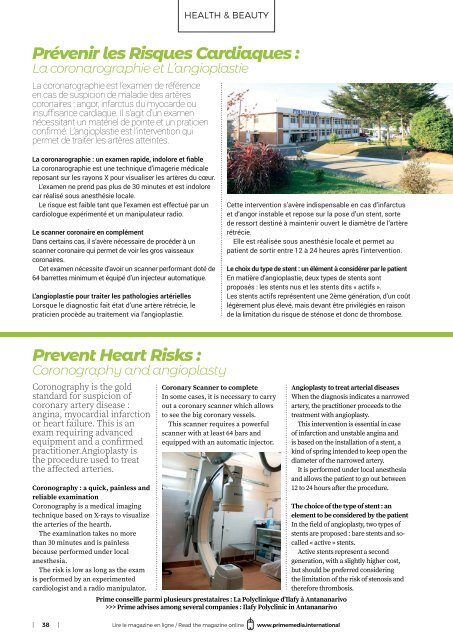PRIME MAG - AIR MAD - MARCH 2018 - SINGLE PAGES - web
You also want an ePaper? Increase the reach of your titles
YUMPU automatically turns print PDFs into web optimized ePapers that Google loves.
HEALTH & BEAUTY<br />
Prévenir les Risques Cardiaques :<br />
La coronarographie et L’angioplastie<br />
La coronarographie est l’examen de référence<br />
en cas de suspicion de maladie des artères<br />
coronaires : angor, infarctus du myocarde ou<br />
insuffisance cardiaque. Il s’agit d’un examen<br />
nécessitant un matériel de pointe et un praticien<br />
confirmé. L’angioplastie est l’intervention qui<br />
permet de traiter les artères atteintes.<br />
La coronarographie : un examen rapide, indolore et fiable<br />
La coronarographie est une technique d’imagerie médicale<br />
reposant sur les rayons X pour visualiser les artères du cœur.<br />
L’examen ne prend pas plus de 30 minutes et est indolore<br />
car réalisé sous anesthésie locale.<br />
Le risque est faible tant que l’examen est effectué par un<br />
cardiologue expérimenté et un manipulateur radio.<br />
Le scanner coronaire en complément<br />
Dans certains cas, il s’avère nécessaire de procéder à un<br />
scanner coronaire qui permet de voir les gros vaisseaux<br />
coronaires.<br />
Cet examen nécessite d’avoir un scanner performant doté de<br />
64 barrettes minimum et équipé d’un injecteur automatique.<br />
L’angioplastie pour traiter les pathologies artérielles<br />
Lorsque le diagnostic fait état d’une artère rétrécie, le<br />
praticien procède au traitement via l’angioplastie.<br />
Cette intervention s’avère indispensable en cas d’infarctus<br />
et d’angor instable et repose sur la pose d’un stent, sorte<br />
de ressort destiné à maintenir ouvert le diamètre de l’artère<br />
rétrécie.<br />
Elle est réalisée sous anesthésie locale et permet au<br />
patient de sortir entre 12 à 24 heures après l’intervention.<br />
Le choix du type de stent : un élément à considérer par le patient<br />
En matière d’angioplastie, deux types de stents sont<br />
proposés : les stents nus et les stents dits « actifs ».<br />
Les stents actifs représentent une 2ème génération, d’un coût<br />
légèrement plus élevé, mais devant être privilégiés en raison<br />
de la limitation du risque de sténose et donc de thrombose.<br />
Prevent Heart Risks :<br />
Coronography and angioplasty<br />
Coronography is the gold<br />
standard for suspicion of<br />
coronary artery disease :<br />
angina, myocardial infarction<br />
or heart failure. This is an<br />
exam requiring advanced<br />
equipment and a confirmed<br />
practitioner.Angioplasty is<br />
the procedure used to treat<br />
the affected arteries.<br />
Coronography : a quick, painless and<br />
reliable examination<br />
Coronography is a medical imaging<br />
technique based on X-rays to visualize<br />
the arteries of the hearth.<br />
The examination takes no more<br />
than 30 minutes and is painless<br />
because performed under local<br />
anesthesia.<br />
The risk is low as long as the exam<br />
is performed by an experimented<br />
cardiologist and a radio manipulator.<br />
Coronary Scanner to complete<br />
In some cases, it is necessary to carry<br />
out a coronary scanner which allows<br />
to see the big coronary vessels.<br />
This scanner requires a powerful<br />
scanner with at least 64 bars and<br />
equipped with an automatic injector.<br />
Prime conseille parmi plusieurs prestataires : La Polyclinique d’Ilafy à Antananarivo<br />
>>> Prime advises among several companies : Ilafy Polyclinic in Antananarivo<br />
Angioplasty to treat arterial diseases<br />
When the diagnosis indicates a narrowed<br />
artery, the practitioner proceeds to the<br />
treatment with angioplasty.<br />
This intervention is essential in case<br />
of infarction and unstable angina and<br />
is based on the installation of a stent, a<br />
kind of spring intended to keep open the<br />
diameter of the narrowed artery.<br />
It is performed under local anesthesia<br />
and allows the patient to go out between<br />
12 to 24 hours after the procedure.<br />
The choice of the type of stent : an<br />
element to be considered by the patient<br />
In the field of angioplasty, two types of<br />
stents are proposed : bare stents and socalled<br />
« active » stents.<br />
Active stents represent a second<br />
generation, with a slightly higher cost,<br />
but should be preferred considering<br />
the limitation of the risk of stenosis and<br />
therefore thrombosis.<br />
| 38 | Lire le magazine en ligne / Read the magazine online www.primemedia.international















